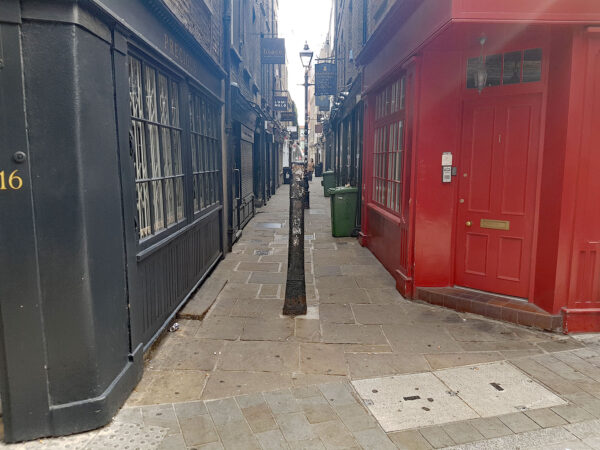This narrow picturesque alley in Spitalfields looks old and is indeed old, far older than it looks. It follows an ancient line that runs along the southern boundary of the old St Mary Spital priory, and the northern side of the Wodeland pastures.
St Mary Spital was the site of the largest infirmary in medieval London, with a total of 180 beds, and the name itself, spital is an archaic slang form of “hospital.”
Closed down by the dissolution of the monasteries, the southern fields were leased in 1537 to the Fraternyte or Guylde of Artyllary of longebowes, Crossebowes and handegonnes for 297 years, and its from that use that the area gained its name of the Artillery.
They didn’t keep it for that long though, and in 1682, George Bradbury and Edward Noell bought the Artillery Ground for £5,700 with a license to build new houses. They began to develop the area in association with two city merchants, Nicholas Barbon and John Parsons.
It was they who laid out the narrow warren of streets that exist today and delight so many visitors and tourists with this maze-like cluster of old buildings and hipster fashionable shops.
What is today Artillery Passage had a large row of shops or houses built on its north side, and was at the time known as Smock Alley, although when it changed to its current name is unclear.
Today, the buildings that line the narrow passage are mainly narrow-fronted Georgian houses with mansard roofs and retail uses on the ground floor. They are not set back from the street or lane, and form continuous building lines and a clearly defined enclosure to the street.
What adds to the charm of this alley is the details that remain, such as the original panelled front doors and in places the shutters and ironwork.
While the alley could do with a bit of a clean, and the modern bins removed, it’s a delightful piece of history right next to the skyscrapers of Bishopsgate.










How lovely to see the history of an alley that I have frequently taken! Why I am usually in this area is to arrive to Liverpool Street via the Central Line and walk over to Rough Trade East for some event. 😀 I always try to take as many little, winding passageways on my walk between RTE and Liverpool Street Station. This is one I frequent.
And now looking at this map I see it is right near FRYING PAN ALLEY! Seriously!? I’ve never taken that one. I must, now!
Anyway, any time I’m in the City now, and as I pass these little alleyways, I always think of you and your meticulous research into these delightful little walkways, ever since you started this series. I love them!
Lovely to see some pictures of Artillery Passage. My office was in this little street for 7 years between 2001 and 2008.
When looking at the first picture above you can see another small alley to the left, there was an original Banksy stencil of Jack the Ripper there for a number of years just as you turned left.
Also on the left just beyond that alley was a small independent convenience shop used by locals that was run by a man known simply as ‘brother’. He got the name as he greeted every customer as such, ‘yes brother, what would you like…’ he was a lovely old man who took unwell in the end.
Across from that shop you can see ‘Grapeshots’ which was a bar run for a long time by a Wolves football fan. It was a quaint place populated by equally quaint customers.
Also in Artillery Passage were ‘the eat and drink’ which was a well known late night Chinese restaraunt and karaoke bar and ‘the bolthole’ Which was a very small bar on the right at the opposite end of the passage, they did a nice draught beer I forget the name.
Around 2005 the passage began to change as the Spitalfields area was gentrified and now most businesses have changed and the people have moved on. Certainly within that 10 years period from 2000 to 2010 there was a great little community in the area of shops and bars and a real east London vibe in The Kings Store Bar, the Williams wine and Ale house, the Gun pub and the surrounding area. Oliver Sweeney’s first shop was also just off Bishopsgate about 50 yards up from the passage and did some cool shoes and clothes. I wonder what happened to the charismatic chap who used to ask for money ‘cos I’m saving up for a holiday to Barbados’.
Thank you Ian! This is an area with a lot of family history, and this article helped me identify the otherwise unreadable street address of some ancestors. Smock Alley is mentioned in death records in 1812, but by 1815, Artillery Passage appears. This helps to narrow down when the name changed.